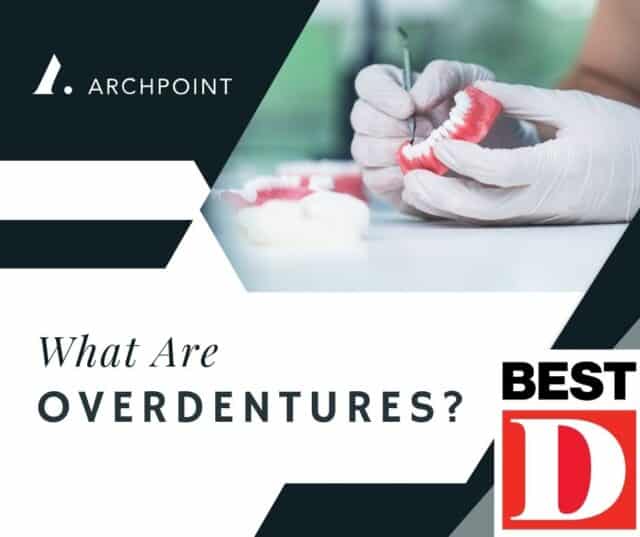If you’ve ever heard of an “overdenture” it’s safe to assume that it’s some type of a modified denture that’s worn over something. In this case, it’s dental implants. But what makes an overdenture different from traditional dentures, partials, or even a full-arch implant system like All-on-4?
For people who are still trying to decide between implants, dentures, or in this case—overdentures—here’s everything you need to know about how overdentures compare to other traditional tooth replacement treatments.
What Do Overdentures Look Like and How do They Work?
To put it simply, an overdenture is a traditional denture that has special locators (or “buttons”) built into it that allow it to attach to dental implants. Most overdentures are stabilized with anywhere from 2-4 implants, depending on if it’s an upper or lower denture.
An overdenture is removable. It’s meant to take out at the end of the day like you would conventional dentures or partials.
In some cases, it’s possible to retrofit existing dentures with new locators, transitioning them into an overdenture if you decide to get dental implants. Not always, but sometimes.
Overdentures vs. Traditional Dentures
Since overdentures are removable and still rest on top of your gums, how are they any different from traditional “plate” style dentures? It’s simple: they offer better security throughout the day.
With a traditional denture, your prosthesis relies on suction to keep it in place. And if you have extensive bone loss—which is common for denture wearers because tooth loss causes the bone to shrink away—it’s even harder to hold a denture in place. So, individuals usually turn to denture adhesives, pastes, or strips that create a sticky surface to help keep their dentures from slipping around. But these are all messy and hard to clean. And even with extensive bone loss, they don’t work.
On the other hand, we can create your denture so that it has special places to clip onto two or four implants in your jaw. That way once you press it down into place, it’s adhering to the dental implants instead of sticky residue or creating a suction. The added stability allows you to talk and eat without having to worry as much about your prosthesis coming out, slipping, or rubbing.
A big perk of using implants to stabilize your dentures is that it makes them more comfortable to wear on an everyday basis. Most people find it difficult to transition into a denture, because of the rubbing or sore spots it creates on their gums. When you’re having to use your lips, tongue, and cheeks to keep your dentures in place, everyday activities like talking on the phone are extremely difficult. Whereas when your denture attaches onto implants, it frees up all of your other oral muscles to do things like talk, chew, and swallow.
Overdentures vs. All-on-4 Implants
You can think of overdentures as a step up from traditional dentures, but a step down from All-on-4 or All-on-6 implants. To understand why that’s the case, you first need to understand how an All-on-4 system works.
All-on-4 implants are like a hybrid between dentures and a full arch dental bridge. They tend to be “U” shaped, following the natural curve of your jaw. Like dentures, they include some pink areas to fill in the height and shape of your gums. But they don’t cover the roof of your mouth because there’s no need for them to. An All-on-4 system is retained by four implants in your arch, so it’s not going anywhere.
Overdentures still have the “plate” that goes across the roof of your mouth like traditional dentures. Even though they clip onto implants, the implants act more like an added layer of stability. You still need the traditional shape of the denture in order for your appliance to fit your mouth properly.
The biggest difference between All-on-4 implants and overdentures is that All-on-4 is permanent, and overdentures are removable. You absolutely have to take overdentures out at the end of every day. Whereas it’s impossible to remove All-on-4 implants, at least on your own. Your dentist could remove them with special instruments to examine and clean the area, but otherwise, they stay in place like a bridge would.
With All-on-4 being permanently fixed, you also have some added biting and chewing capabilities that you don’t quite get with overdentures. Such as being able to bite into an apple or easily chew up a steak. However, overdentures are still an improvement from traditional dentures when it comes to being able to eat more easily. Deciding between which one you want will ultimately boil down to what your priorities are, how comfortable you want to be, and the budget that you plan on working with.
Other Names for Overdentures
Overdentures are just one word we use to describe this unique tooth-replacement prosthesis. They’re also called “implant stabilized” or “implant retained” dentures because we’re essentially stabilizing them with dental implants.
Some people refer to implant stabilized overdentures as “snap-on” or “clip-in” dentures. Because they are snapping or clipping onto the corresponding dental implants in your mouth. You snap them into place for the day and go on your way. At the end of the day, simply unclip them to take them out of your mouth. Normally we don’t call the special attachments a snap or clip, but it is a type of a button that slips on top of your implant abutments.
“Snap On” Overdentures in DFW
If you’re torn between wearing dentures or getting a permanent, fixed All-on-4 treatment, overdentures provide a great mid-way solution for your smile. Especially if you need quick results or are working with a tighter budget. The implant specialists at ARCHPOINT will help you weigh the pros and cons of your various options, to select the one that’s best for your smile and lifestyle. In this case, it might be a clip-on overdenture.
Reserve a consultation with us today at our office in Ft. Worth or Dallas to learn more.








